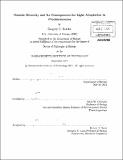Genetic diversity and its consequences for light adaptation in Prochlorococcus
Author(s)
Kettler, Gregory C. (Gregory Carl)
DownloadFull printable version (38.72Mb)
Other Contributors
Massachusetts Institute of Technology. Dept. of Biology.
Advisor
Sallie W. Chisholm.
Terms of use
Metadata
Show full item recordAbstract
When different cells thrive across diverse environments, their genetic differences can reveal what genes are essential to survival in a particular environment. Prochlorococcus, a cyanobacterium that dominates the open ocean, offers an opportunity to explore such differences. Its diversity is examined here, beginning with an overview and comparison of 12 fully sequenced Prochlorococcus genomes. The Prochlorococcus core genome, that set of genes shared by all cultured Prochlorococcus, appears to be well defined by the set shared by these isolates. The flexible genome, that set of genes found in some isolates but not shared by all Prochlorococcus, was found to be much larger and open-ended. Most laterally-acquired genes were found to be located in highly variable islands such as those described in previous studies of Prochlorococcus. Those lateral gene transfer events can also be placed on the Prochlorococcus phylogenetic tree: each Prochlorococcus isolate possesses a significant number of genes that even its closest sequenced cousin does not. A particular gene family may define a Prochlorococcus ecotype if those genes are possessed by all members of that ecotype, and if their presence gives that ecotype a selective advantage in some circumstance, thus contributing to the determination of its niche. One gene family is conspicuous for appearing in many copies per genome in one Prochlorococcus clade, referred to as eNATL. The sequenced strains belonging to this clade each possess over 40 copies of genes encoding high light inducible proteins (HLIPs), compared to only 9-24 in the other Prochlorococcus genomes. Other studies suggest these genes may be involved in resistance to sudden increases in light intensity, among other stresses. This becomes especially interesting as recent field studies also found that eNATL cells may survive changes in light intensity more easily than other lowlight adapted Prochlorococcus. Here, the effects of light shocks on an eNATL strain and on other Prochlorococcus strains are studied. eNATL cultures do recover from light shock conditions that are lethal to other low light-adapted Prochlorococcus. Measurements of bulk in vivo chlorophyll fluorescence, fluorescence per cell, and variable fluorescence, along with preliminary gene expression data, suggest that the early, rapid response of high light-adapted cells and of eNATL cells distinguish them from other low light-adapted cells, possibly explaining their subsequent survival. The possible role of HLIPs in this response is discussed. The discussion of HLIPs and eNATL is based on the complete sequences of only two eNATL genomes, both sampled from the same part of the ocean at the same time. That dataset is expanded by the inclusion of Global Ocean Survey environmental shotgun reads, from which are identified several thousand HLIP genes. Past work has shown that HLIPs are divided into two distinct clades: the core, freshwater cyanobacteria-like HLIPs and the flexible, phage-like, island-bound copies. That distinction is examined in the metagenomic data, demonstrating that the separate types are consistently found in distinct chromosomal neighborhoods. (cont.) The evolution of HLIPs is also explored by the analysis of large-insert environmental clones containing islands from a variety of eNATL cells. Here, not even all island-bound, HLIP-encoding genes appear to be alike, as only a subset are consistently found in the same locations across the whole eNATL clade. Ecotype-defining genes are those genes, shared by all members of an ecotype, that provide an ecologically significant advantage, thus helping to define the ecotype's niche. It can be expected that, as environmental data accumulates (including additional measurements of Prochlorococcus abundance and newly sequenced genomes from uncultured cells), additional such genes can be identified. This work should represent a model for searching for and examining such genes. Hopefully, future experiments will be able to test the physiological significance of candidate ecotype-defining genes, while feeding back to the environmental data to verify their importance in the open ocean.
Description
Thesis (Ph. D.)--Massachusetts Institute of Technology, Dept. of Biology, 2011. Cataloged from PDF version of thesis. Includes bibliographical references (p. 215-223).
Date issued
2011Department
Massachusetts Institute of Technology. Department of BiologyPublisher
Massachusetts Institute of Technology
Keywords
Biology.